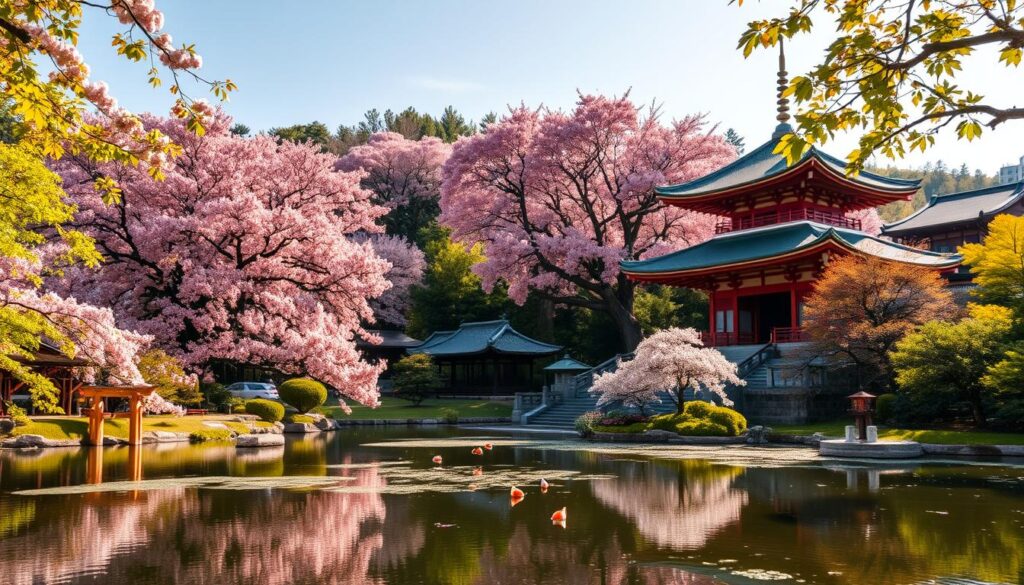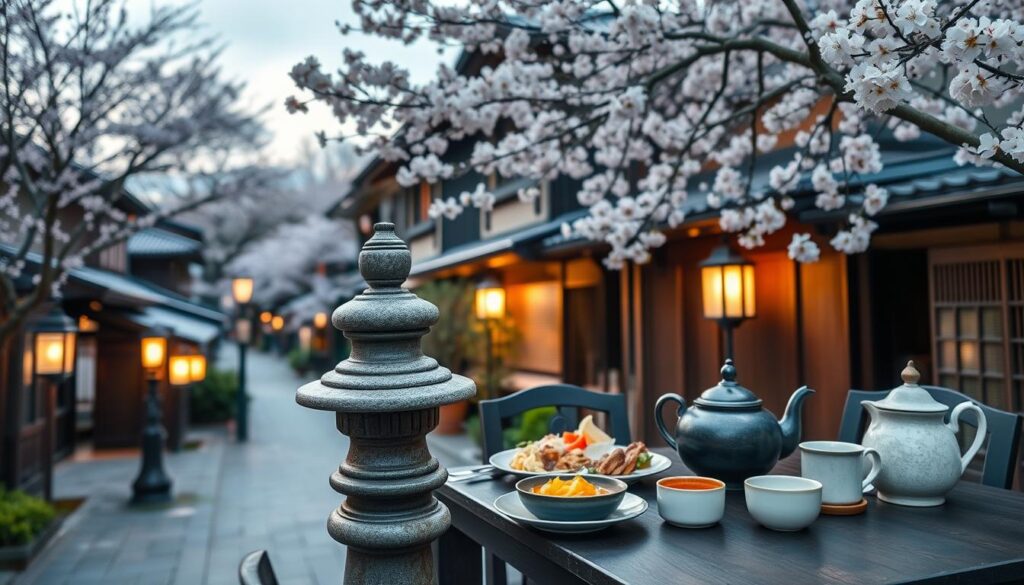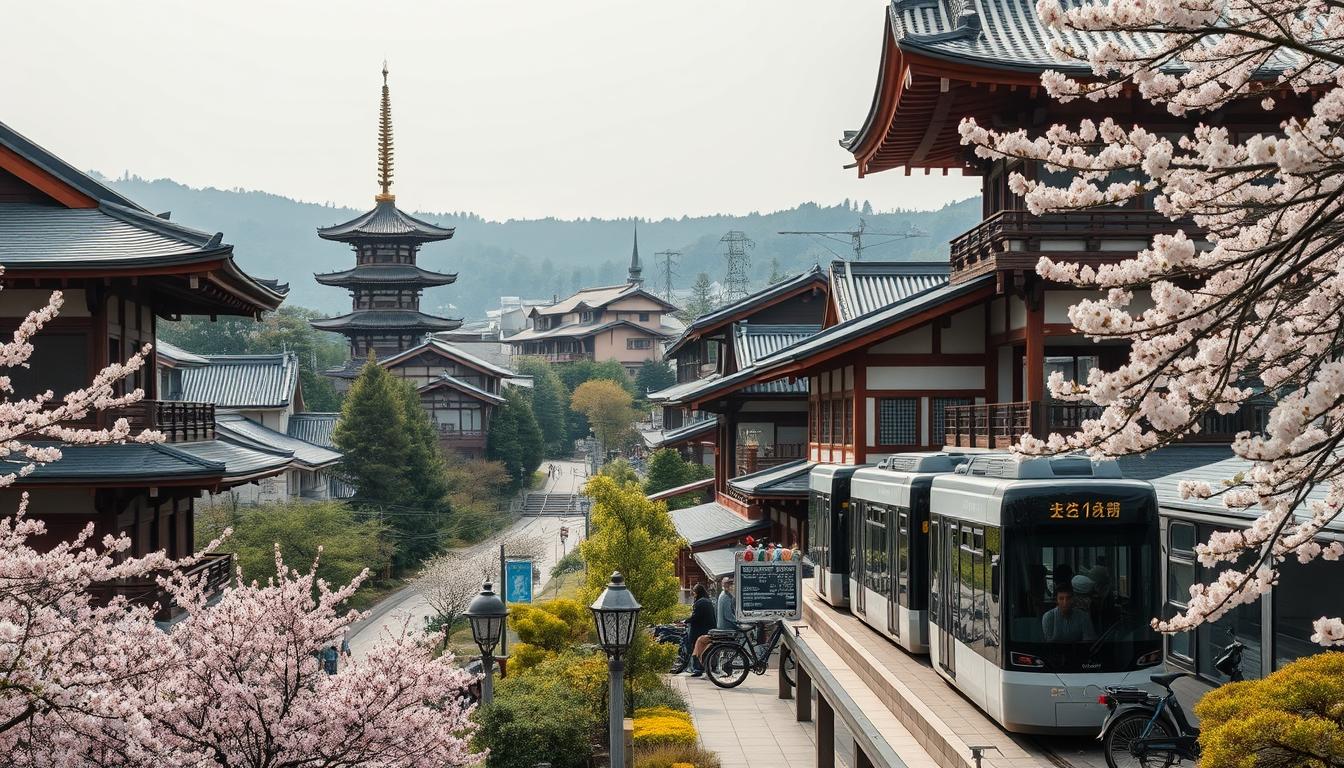“As an Amazon Associate I earn from qualifying purchases.” .
Have you ever dreamed of a place where old traditions meet new wonders? Kyoto, Japan’s heart, invites you in 2025. It’s a city where the past whispers secrets and the future unfolds.
Kyoto is a mix of calm Zen gardens and lively markets. You can find peace in Buddhist temples or join the fun in local festivals. Whether you’re here for a day or a week, Kyoto has something for everyone.
Food lovers will enjoy Kyoto’s food scene, from fancy restaurants to secret dumpling spots. Nature fans can explore mountains and gardens. History enthusiasts will love the ancient streets and shrines. And for romance, Kyoto has the perfect spots for love to grow.
Exploring Kyoto is part of the fun. The city has great buses, taxis, and trains. Plus, Tokyo and Osaka are close, so you can see more of Japan.
Key Takeaways
- Kyoto offers diverse itineraries for all types of travelers in 2025
- The city’s culinary scene ranges from haute cuisine to local street food
- Famous temples, secret alleyways, and zen gardens await exploration
- Efficient public transportation makes Kyoto sightseeing convenient
- Nearby cities like Osaka and Nara are perfect for day trips
- Booking accommodations and travel insurance is easy with online resources
- A Japan Rail Pass can be valuable for frequent train travelers
Best Times to Visit Kyoto in 2025
Kyoto is a city filled with history and culture. It offers unique experiences all year round. Let’s look at the best times to visit Kyoto in 2025, focusing on seasonal events and cultural attractions.
Spring: Cherry Blossoms and Mild Weather
Spring in Kyoto is magical. From March to May, the city is filled with cherry blossoms. April has comfortable temperatures, around 19°C (67°F). It’s perfect for outdoor activities and seeing cultural attractions in bloom.
Summer: Festivals and Local Culture
Summer in Kyoto is lively. July and August are hot, with highs of 33°C (91°F). Despite the heat, it’s great for local festivals and enjoying Kyoto’s culture.
Fall: Vibrant Autumn Foliage
Fall is a great time to visit Kyoto. October and November have pleasant weather, from 13°C to 22°C (56°F to 73°F). The city’s gardens and temples show off stunning autumn colors.
Winter: Tranquility and Snow-Covered Temples
Winter in Kyoto, from December to February, is serene. It’s cold, with temperatures often at 1°C (34°F). But, the snow-dusted temples are magical. It’s a good time for indoor cultural attractions and traditional winter food.
| Season | Average High Temp | Average Low Temp | Key Attractions |
|---|---|---|---|
| Spring (Mar-May) | 13°C – 24°C | 4°C – 14°C | Cherry blossoms, mild weather |
| Summer (Jun-Aug) | 27°C – 33°C | 18°C – 24°C | Festivals, cultural events |
| Fall (Sep-Nov) | 17°C – 28°C | 8°C – 20°C | Autumn foliage, pleasant weather |
| Winter (Dec-Feb) | 9°C – 11°C | 1°C – 3°C | Snow-covered temples, winter cuisine |
Key Attractions to Experience in Kyoto
Kyoto, Japan’s cultural heart, is a mix of old traditions and new wonders. It’s the third most visited place in Japan, welcoming over 12 million visitors in 2023. Let’s dive into the city’s top sights.
Historical Sites: Temples and Shrines
Kyoto’s Temples and Shrines are key to its traditional charm. The Fushimi Inari Shrine is famous for its red gates. Southern Higashiyama is home to temples like Sanjusangen-do and Kiyomizu-dera. The Kyoto Imperial Palace shows Japan’s royal past with its detailed interiors.

Gardens and Parks: Natural Beauty
Nature enthusiasts should see the Arashiyama Bamboo Grove. It’s a peaceful spot just 30 minutes from the city. The Weeping Plum Blossoms festival at Jonangu Shrine in February is breathtaking. Cherry blossom season in April turns the city pink, drawing visitors from all over.
Modern Attractions: Museums and Art Centers
For a modern take on Kyoto, check out Kyoto Tower. It’s the city’s tallest structure, with views of nearby cities. Pontocho alley is a lively spot with its many restaurants and atmosphere.
| Attraction | Type | Notable Feature |
|---|---|---|
| Fushimi Inari Shrine | Historical | Red torii gates |
| Arashiyama Bamboo Grove | Natural | Wooden paths through bamboo |
| Kyoto Tower | Modern | Panoramic city views |
| Pontocho Alley | Cultural | Diverse dining options |
Cultural Etiquette for Visitors
Kyoto’s Cultural Attractions give a peek into Japan’s deep history. To enjoy Kyoto’s Traditional Experiences fully, visitors must respect local customs. With only 1.5% of Japan’s people being expats, and Westerners being just 0.01%, being culturally sensitive is key.
Understanding Local Customs
Japanese etiquette is all about respect and thoughtfulness. Don’t eat on sidewalks or talk loudly on public transport. Cash is better than cards, and tipping is not expected.
In hot springs and public baths, men and women have separate areas. Tattoos might be banned in some places.
Dress Code for Temples and Shrines
At Kyoto’s 2000 temples and shrines, dress modestly. Wear clothes that cover your shoulders and knees. Remove your shoes before entering sacred areas.
Some places offer wraps or robes for visitors. Dressing appropriately makes your visit better at these Cultural Attractions.
Appropriate Behavior in Public Spaces
Your behavior in public reflects on you and your country. Speak softly on trains and avoid making phone calls. Smoking while walking is not allowed.
Find designated smoking areas. When eating out, finish your meal as leftovers are seen as wasteful. For sushi, only dip the fish in soy sauce, not the rice.
“When in Kyoto, do as the Kyotoites do. Respect for local customs enhances your journey through this cultural treasure trove.”
By following these tips, you’ll make your Kyoto Traditional Experiences richer. Your thoughtful behavior helps keep Kyoto’s charm alive for others.
Unique Culinary Experiences in Kyoto
Kyoto’s dining scene is a feast for the senses. It blends ancient traditions with modern culinary art. Visitors get to enjoy unforgettable traditional experiences that excite their taste buds and dive into centuries-old food culture.
Traditional Kaiseki Cuisine
Kaiseki is the top Japanese haute cuisine in Kyoto. It’s a multi-course meal with seasonal ingredients. Each dish is made with great care, showing off the flavors, textures, and presentations of the season and local specialties.
Must-Try Street Food
Kyoto’s streets are full of flavors for a casual dining experience. The Nishiki Market, known as “Kyoto’s Kitchen,” is buzzing. Here, you can try local treats and buy unique ingredients. From grilled mochi to soy milk donuts, the market’s 100+ stalls offer a delicious taste of Kyoto’s street food.
Tea Culture: Matcha & Tea Houses
Visiting Kyoto without trying its tea culture is missing out. The city is where the traditional tea ceremony started. It’s a practice of mindfulness and respect. You can join a ceremony or just enjoy a cup of matcha at a tea house, finding peace in the city’s noise.
| Cooking Class Type | Price Range | Duration | Location |
|---|---|---|---|
| Kyoto Ramen Cooking Class | $$$ | 2-3 hours | Kamigyō-ku |
| Traditional Sushi-Making Class | $$ | 2-3 hours | Higashiyama-ku |
| Japanese Bento Cooking Class | $ | 1.5-2 hours | Shimogyō-ku |
| Izakaya Cooking Class | $ | 2-3 hours | Sakyō-ku |
| Sushi Making with a Sushi Chef | $$ | 3-4 hours | Nakagyō-ku |
Kyoto’s food scene has something for everyone, including vegetarians and vegans. Whether you’re in a cooking class or on a food tour, you can dive into the city’s rich food heritage. These experiences create memories that last long after the meal is over.

“In Kyoto, every meal is a work of art, every bite a journey through time.”
Getting Around: Transportation Options
Kyoto offers many ways to explore its historic streets. You can use six train lines, two subway routes, and a wide bus network. This makes getting around Kyoto easy and fun.
Public Transit: Buses and Subways
The subway in Kyoto is both efficient and cheap. The fare starts at 220 yen, and it can go up to 360 yen based on how far you travel. Buses cover almost the whole city, great for finding temples or shrines. For those on a tight budget, the Kansai Thru Pass is a good deal for five days of unlimited travel.
Bicycles: Eco-Friendly Exploration
Kyoto is one of the best cities for biking. Its flat streets and grid layout make it easy to ride. Renting a bike lets you see the city’s hidden spots and enjoy its streets at your own pace.
Walking Tours: Discovering Hidden Gems
Walking is perfect for seeing Kyoto, like in Higashiyama. The Philosopher’s Path, with its cherry trees, is a beautiful walk. Kyoto’s grid layout makes walking easy, letting you find secret temples and shops.
| Transport Type | Starting Fare | Best For |
|---|---|---|
| Subway | 220 yen | Quick city traversing |
| Bus | Varies | Reaching specific sites |
| Taxi | 500 yen (first 1km) | Small groups, direct routes |
| Bicycle | Rental fees vary | Eco-friendly city exploration |
Try the Keifuku Electric Railroad (Randen) for a special ride. It’s a charming streetcar that goes by famous temples. During busy times, trains and subways are faster and more comfortable for your Kyoto trip.
Accommodations: Where to Stay in Kyoto
Kyoto has many places to stay, from fancy hotels to cozy hostels and traditional ryokans. There’s something for everyone, no matter your budget.
Luxury Hotels and Resorts
Looking for top-notch places to stay? Kyoto has them. The Ritz-Carlton Kyoto is a standout. It mixes modern luxury with Japanese style. Plus, it’s in Downtown Kyoto, close to lots of restaurants, shops, and cultural spots.
Budget-Friendly Hostels
Need to save money? Central Kyoto has many affordable options. Piece Hostel Sanjo and K’s House Kyoto are great choices. They offer a comfy stay and let you experience Kyoto without spending a lot.
Traditional Ryokans
Want a real Kyoto experience? Stay in a ryokan. Seikoro and Nazuna Kyoto Gosho offer luxury. Ishibeikoji Muan and Nishiyama Ryokan are more affordable. These inns give you a peek into Japanese culture and hospitality.
| Accommodation Type | Price Range (per night) | Best Areas |
|---|---|---|
| Luxury Hotels | $300+ | Downtown Kyoto, Southern Higashiyama |
| Budget Hostels | $20-$50 | Central Kyoto, Kyoto Station Area |
| Traditional Ryokans | $100-$500+ | Gion, Arashiyama, Kibune |
Book your stay in Kyoto early, esp. during cherry blossom (March-April) and fall foliage (November). Hotels fill up fast during these times.
Choosing a luxury hotel, a cozy hostel, or a traditional ryokan in Kyoto will make your trip unforgettable. It’s a journey through history.
Kyoto Travel Passes: Pros and Cons
Planning your Kyoto trip for 2025? Travel passes can make your journey smoother and cheaper. They’re a great way to explore Kyoto without overspending.
One-Day Passes and Multi-Day Options
Kyoto has many pass types for different needs. One-day passes are good for short trips. Multi-day passes are better for longer stays. Here are the most popular ones:
| Pass Type | Duration | Price (¥) | Best For |
|---|---|---|---|
| City Bus Pass | 1 day | 600 | City exploration |
| Subway Pass | 1 day | 900 | Quick city transit |
| JR Pass | 7 days | 50,000 | Extensive travel |
| Kansai Area Pass | 3 days | 6,300 | Regional exploration |
Which Pass is Right for You?
Choosing the right pass depends on your plans. A city bus pass is good for staying in Kyoto. The Kansai Area Pass is best for visiting Osaka or Nara. The JR Pass is for those exploring Japan more broadly.
Tips for Maximizing Your Travel Pass
To get the most from your pass:
- Plan your route in advance
- Group attractions by location
- Use your pass for longer trips
- Consider off-peak travel times
Remember, passes might not always be the cheapest. Sometimes, buying individual tickets can save money. Always compare prices before you decide.
Kyoto’s charm lies in its blend of tradition and modernity. A well-chosen travel pass can help you experience both without breaking the bank.
Day Trips from Kyoto
Kyoto Tourism has more than city sights. Explore beyond the city for unforgettable day trips. These trips show Japan’s beauty and history, adding to your Kyoto experience.
Nara: A Historical Perspective
Nara is close to Kyoto, blending nature and history. It’s famous for friendly deer and ancient temples. Don’t miss Todai-ji, the world’s largest wooden building, a sight to behold.
Arashiyama: Nature and Scenery
Arashiyama offers a peaceful escape from the city. It’s just 30 minutes from Kyoto. Walk through the famous bamboo forest and see Okochi Sanso Garden’s beautiful Japanese landscaping.
Osaka: Vibrant City Life
Osaka is a short train ride away. It’s a lively city that contrasts with Kyoto’s calm. Enjoy modern attractions, street food, and nightlife for a different adventure.
| Destination | Travel Time | Main Attraction |
|---|---|---|
| Nara | 45 minutes | Todai-ji Temple |
| Arashiyama | 30 minutes | Bamboo Forest |
| Osaka | 1 hour | Dotonbori District |
These day trips from Kyoto offer a variety of experiences. From ancient temples to natural wonders and modern city life. They’re easy to get to and offer unique views of Japanese culture and history, making your Kyoto Tourism experience richer.
Events and Festivals in 2025
Kyoto is alive with vibrant events that celebrate its rich culture. From ancient traditions to modern celebrations, these festivals give visitors a peek into Japanese culture.
Gion Matsuri: A Cultural Spectacle
The Gion Matsuri is a famous festival in July. It lasts a month, filled with grand processions, traditional music, and elaborate floats. Visitors can enjoy street food, see detailed decorations, and feel the excitement of this ancient festival.
Jidai Matsuri: A Celebration of History
The Jidai Matsuri, or “Festival of Ages,” is on October 22. It’s a parade that shows off Kyoto’s history. People wear costumes from different times, making a timeline of the city’s past. It’s great for history lovers and culture fans.
The Kyoto International Film and Art Festival
The Kyoto International Film and Art Festival is a highlight for modern culture. It happens in October and features films, art, and music from around the world. It’s a mix of old and new Japanese culture.
Other notable events in 2025 include:
- Toka Ebisu Festival (January 8-12, 2025)
- Setsubun Bean-Throwing Ceremony (February 3, 2025)
- Aoi Matsuri (May 15, 2025)
- Daimonji Gozan Okuribi (August 16, 2025)
For a full list of Kyoto festivals and events, check the city’s official event calendar. Remember to book your stay early, as prices can go up during festivals.
Sustainable Travel Tips for Kyoto
Kyoto is known for its rich culture. To keep this heritage alive, travelers can choose eco-friendly ways to explore. Let’s see how to enjoy Kyoto’s traditions while being kind to the planet.
Eco-Friendly Activities
Walking or biking is the best way to see Kyoto. With over 1,600 temples and 400 shrines, walking tours give a close look at the city’s heart. Cycling is great for seeing more while being green. Many hotels let you rent bikes, making it easy to explore.
Supporting Local Businesses
Help Kyoto’s community by staying in local places and buying from local shops. Nishiki Market is open from 9 am to 6 pm, where you can try local foods and buy real souvenirs. Staying in traditional ryokans or taking cultural workshops helps keep Kyoto’s heritage alive.
Responsible Sightseeing Practices
Respect local traditions at sacred sites. At Kinkaku-ji (The Golden Pavilion), a 400 JPY fee helps maintain it. Bring a reusable water bottle; Japan’s water is mostly safe and delicious. Traveling during off-peak times lets you enjoy Kyoto’s beauty without the crowds.
- Use public transport to reduce emissions
- Participate in traditional tea ceremonies to support local artisans
- Opt for vegan or vegetarian meals to promote sustainable dining options
By following these tips, you’ll make your Kyoto trip better and help the city’s future.
Preparing for Your Trip to Kyoto in 2025
Planning your trip to Kyoto in 2025 needs careful thought. You want to make sure your visit is smooth and fun. Kyoto is a mix of old traditions and new sights, so pack right and learn about local ways.
Packing Essentials for Different Seasons
Kyoto’s weather changes a lot throughout the year. Wear light, airy clothes in summer and warm ones in winter. Comfortable shoes are key for walking around Kyoto.
Also, bring a small umbrella, as June is the wettest month.
Language Tips for Tourists
English is common at tourist spots, but knowing Japanese helps a lot. Learn basic phrases before you go. A translation app can also be very helpful.
Safety and Health Precautions
Kyoto is mostly safe, but it’s smart to be careful. Use sunscreen with SPF 30 or more. Check if you can bring your medicines.
Remember to respect local customs, like removing shoes in some places. And don’t forget travel insurance that covers over 150 activities for peace of mind.
FAQ
What is the best time to visit Kyoto in 2025?
What are some must-visit attractions in Kyoto?
What cultural etiquette should I be aware of when visiting Kyoto?
What unique culinary experiences can I have in Kyoto?
What are the best transportation options for getting around Kyoto?
What types of accommodation are available in Kyoto?
Are there any travel passes available for exploring Kyoto?
What are some popular day trips from Kyoto?
What major events and festivals will be happening in Kyoto in 2025?
How can I practice sustainable travel in Kyoto?
What should I pack for my trip to Kyoto in 2025?
“As an Amazon Associate I earn from qualifying purchases.” .



